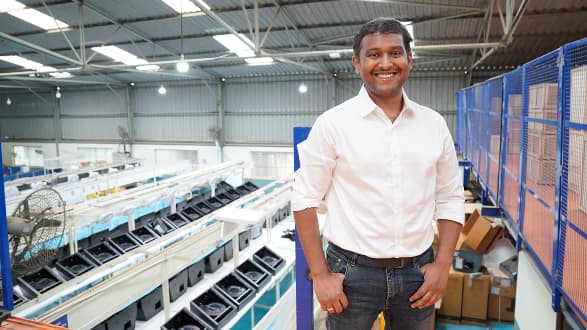In this interview, Vikas speaks at length from AI-driven personalisation and IoT connectivity to smoke management and self-cleaning systems that Beyond Appliances is crafting

Eshwar K Vikas, CEO & Co-founder, Beyond Appliances
In most Indian homes, the kitchen isn’t just a place to cook—it’s a sacred space where tradition, culture, and family life intersect. Yet, despite being the very heart of the household, it has remained largely untouched by the kind of technological disruption that has transformed so many other aspects of modern living. Spotting this paradox, Eshwar K Vikas, CEO & Co-founder of Beyond Appliances, saw an opportunity to reimagine the Indian kitchen.
With a background in automating commercial kitchens through Mukunda Foods and a vision to blend tradition with cutting-edge innovation, Eshwar joined forces with co-founder Rakesh Patil, an engineer with experience in projects as advanced as Tejas aircraft engines. Together, they set out to create kitchen solutions designed not for global replication but for local relevance—smart, efficient, and deeply intuitive appliances tailored to the unique demands of Indian households.
In this interview, Vikas speaks at length from AI-driven personalisation and IoT connectivity to smoke management and self-cleaning systems that Beyond Appliances is crafting. It is rather creating a future where the Indian kitchen becomes not just smarter, but healthier, more connected, and more inspiring.
What was the core inspiration behind starting Beyond Appliances, and how does the brand differentiate itself in India’s highly competitive consumer electronics space?
The inspiration behind Beyond Appliances comes from a simple yet powerful realisation: the kitchen, despite being the heart of every Indian home where families spend hours daily, has witnessed little real technological evolution. While innovation has touched nearly every part of our lives, the Indian kitchen, deeply rooted in tradition, remained unchanged. As an electrical engineer and entrepreneur, I had earlier worked on automating commercial kitchens with Mukunda Foods and saw the opportunity to bring the same revolution into households.
Alongside my co-founder, Rakesh Patil, whose experience spans advanced engineering projects like Tejas aircraft engines—we set out to reimagine the modern Indian kitchen. My expertise in automation and design, combined with his high-performance engineering background, allowed us to build appliances that are efficient, reliable, and future-ready.
Beyond Appliances is not just another consumer electronics brand. Our mission is to make kitchens smarter, healthier, and more intuitive by addressing everyday cooking challenges through innovation. From advanced smoke management systems to precision cooking and time-saving automation, every feature is designed with Indian households in mind.
What sets us apart is our belief that appliances should enhance lifestyles. By harnessing AI, IoT, and connected ecosystems, we’re creating products that adapt, learn, and deliver consistently—transforming kitchens into interactive, inspiring spaces for families to cook, connect, and live better.
What market white spaces or unmet consumer needs did you notice that led to the creation of Beyond Appliances?
When we studied the Indian kitchen, it became clear that there were significant white spaces that existing consumer electronics brands had overlooked. Kitchens are deeply cultural and emotional spaces in India, yet most appliances available in the market were either imported designs that didn’t reflect local cooking needs or traditional appliances that hadn’t meaningfully evolved with changing lifestyles.
Our consumer research revealed three critical unmet needs:
Efficiency without disruption – Home cooks wanted to save time and effort but didn’t want appliances that forced them to abandon their traditional cooking styles. They were looking for upgrades that fit naturally into their routines.
Integrated experiences – We noticed that many multitasked while cooking—listening to music, watching recipes, or engaging with family—yet their appliances were not designed to support this modern, connected lifestyle. The lack of integration left the cooking experience fragmented.
Tech-enabled convenience with local relevance – While global brands offered advanced appliances, they often failed to address very Indian pain points like smoke management, spice-heavy cooking, or compact kitchens. This created a clear white space for solutions built specifically for Indian households.
These insights shaped our approach at Beyond Appliances. Instead of replacing traditional appliances, we enhanced them with AI-driven personalization, IoT-enabled connectivity, and intuitive interfaces. Another major gap we identified was in after-sales service. Consumers often felt abandoned once they purchased a product. To address this, we built best-in-class customer service into our DNA, ensuring that our appliances are supported by a responsive, tech-enabled service network.
What are the key demand drivers shaping the appliances category today, and how do you see consumer expectations evolving in terms of product design, technology, and affordability?
The appliances category is being reshaped by changing lifestyles, digitization, and higher expectations around convenience. Busy routines and dual-income households are driving demand for products that save time, automate tasks, and deliver consistent results without constant supervision. Hyper-personalization is another key trend: consumers now expect appliances—like smart fridges or adaptive cooking devices—that learn their preferences and integrate seamlessly into daily routines through AI and IoT connectivity.
At Beyond Appliances, we see consumer expectations evolving rapidly along these lines. The Indian kitchen is unique—spice-heavy cooking, compact layouts, and cultural rituals demand solutions that global products often overlook. That’s why our philosophy is not just to replicate international trends but to create innovations tailored for Indian homes. We are integrating AI-driven precision, IoT connectivity, and immersive features like voice assistance and intuitive interfaces to make kitchens more interactive and effortless. Equally important, we know that innovation must be backed by best-in-class customer service. Consumers today expect seamless support and transparency, and we are embedding service excellence into our brand DNA.
By combining advanced engineering, local manufacturing, and consumer-centric design, Beyond Appliances is building a new narrative of “Made in India” kitchen innovation—world-class in technology, deeply rooted in cultural relevance, and accessible to a wide spectrum of households.
What is your outlook for the kitchen appliances market in India over the next 3–5 years, and what share or growth rate is Beyond Appliances targeting within this period?
The Indian kitchen appliances market is poised for a significant transformation over the next 3–5 years. With rising disposable incomes, rapid urbanization, and a growing preference for convenience-led living, the industry is expected to grow, with premium and smart appliances driving much of this growth. Kitchens are evolving from purely functional spaces into tech-enabled, efficient, and design-forward hubs that reflect modern lifestyles.
At Beyond Appliances, we view this shift as an opportunity to deliver solutions that are not only technologically advanced but also deeply aligned with Indian cooking habits. While much of the market has historically been dominated by appliances designed for international usage, we are bridging the gap with a ‘Made in India, Made for India’ approach—creating products that cater to the unique demands of Indian kitchens, including oil-intensive cooking and long cooking durations.
Currently, Beyond Appliances operates at an annual revenue run rate of approximately Rs 50 crore, with a target to reach an ARR of Rs 400 crore within the next three years. By focusing on intuitive, time-saving features such as self-cleaning, air purification, and integrated entertainment, we aim to redefine how Indian consumers experience their kitchens.
In short, as India embraces smarter living, Beyond Appliances is positioned not just to participate in the market’s growth but to set the benchmark for the future of premium, connected kitchens in the country.
You recently raised $ 4 Mn Series-A funding. How are you deploying these funds across product innovation, supply chain strengthening, retail expansion, and digital transformation?
We recently raised $4 million in Series A funding led by Fireside Ventures, with participation from Dharana Capital. The fresh capital will be strategically deployed across multiple growth levers. A significant portion is being directed toward scaling our manufacturing capabilities, which remain the backbone of our expansion strategy. Beyond currently operates four state-of-the-art manufacturing facilities, and we plan to set up two additional units in the next 12 months. This will not only help us meet the rising consumer demand but also broaden our product portfolio and accelerate our R&D-led innovation pipeline.
At the same time, we are strengthening our supply chain to ensure faster, more efficient deliveries and a seamless customer experience. Parallelly, we are expanding our retail presence across key metros and tier-1 cities while investing in digital transformation to build smarter, more connected kitchen solutions and enhance customer engagement. Together, these investments will help us scale sustainably, reinforce our leadership in the smart kitchen category, and create meaningful value for our customers.
How do you plan to expand distribution both online and offline, and what role will Tier-II and Tier-III cities play in your growth journey?
We’ve served over 1,500 customers across metros like Bangalore, Hyderabad, Chennai, Pune, Mumbai, and Delhi-NCR, with a strong base of repeat buyers. Our products are already available on leading e-commerce platforms as well as select retail stores in Bangalore, and we’re steadily expanding offline availability in other metro hubs.
The response to our latest innovation—the Cube Chimney, India’s first plug-and-play chimney—has been especially encouraging, with over 500 units sold within the first month. This validates both our product design and the growing demand for easy-to-install, smart kitchen solutions.
Looking ahead, Tier-II and Tier-III cities will be pivotal to our growth. As aspirations rise in these markets, we see a strong appetite for premium yet practical kitchen solutions that elevate everyday living. We plan to strengthen online distribution to ensure nationwide accessibility while strategically building offline retail partnerships in high-potential cities. By combining digital reach with local touchpoints, we aim to cater to evolving consumer expectations and accelerate adoption across diverse household structures, from nuclear families to larger joint families.
What are the biggest challenges you foresee in scaling Beyond Appliances, whether in terms of consumer adoption, competition, or the manufacturing ecosystem?
What are the next big innovations or categories Beyond Appliances is exploring, and what is your long-term vision for the brand?
Over the next two years, our primary focus will be on deepening innovation in the chimney, cooktop, and hob-top categories, where we see significant scope for enhancing performance, safety, and user experience. We plan to expand our product lines within these categories and introduce new solutions that integrate advanced technology with everyday kitchen needs.
Looking ahead, our long-term vision is to establish Beyond Appliances as a leader in smart kitchen technology by continuing to build a connected ecosystem of products that make kitchens more efficient, interactive, and enjoyable. While our immediate roadmap remains centered on chimneys, cooktops, and hobtops, our broader mission is to keep innovating within the kitchen space, gradually expanding into complementary product lines that align with our vision of transforming the modern Indian kitchen.
Empower your business. Get practical tips, market insights, and growth strategies delivered to your inbox
By continuing you agree to our Privacy Policy & Terms & Conditions
